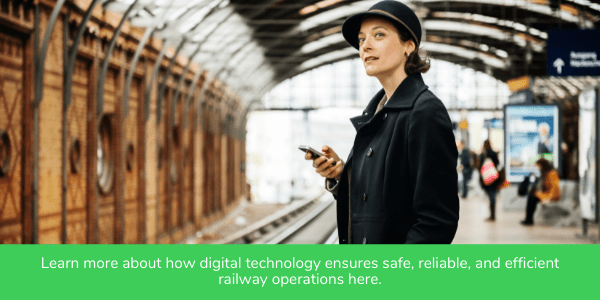1.8 billion people travel by rail every day – but reliability is a common problem
Railways – both long-distance and urban – have one mandate: provide reliable transportation that gets passengers to their destination safely and on time. That’s no small feat, considering that in the EU alone railways transport over 7 billion passengers and 1.6 billion tons of freight each year. A single delay, such as a maintenance problem, can quickly escalate into lengthy secondary delays that affect other trains’ operations. That has monumental consequences for busy metro systems that may be responsible for moving millions of people a day.
The fact is, many railways struggle to meet reliability challenges. For example, along the U.S.’s busiest passenger rail corridor, infrastructure-related issues caused 328,000 train-delay minutes in one year – the equivalent of around 700 seven-hour train trips.
Digitizing railways gets people to their destination safely and on time
Modernized, future-ready railways know that improving reliability and avoiding these delays starts with adopting digital technology and advanced software, like sensors, digitized power systems, remote monitoring, and data analytics. That’s because these digital technologies let railway operators make informed decisions and define new operational and maintenance strategies. Digitization programs are already well underway in many countries. For example, Germany’s Deutsche Bahn is digitizing its entire network and expects these technologies will increase the network’s capacity by up to 20 percent.

It also improves the reliability of critical equipment like signaling systems
Railway systems are complex but managing them doesn’t have to be. Using digital technology simplifies operations because railways can now safely automate time-consuming activities, ensure a stable power system, and monitor assets remotely.
Digitizing signaling systems is one way railways are ensuring safe operations and on-time trains. For example, track and signaling faults are the main cause of Norway’s railway delays. However, the areas where the signaling systems have been upgraded are now the most punctual stretches in the country. Digitized signaling enhances reliability and performance. In contrast, outdated signaling systems may not be able to gather even basic information, such as the precise location of a train, which can lead to delays and safety issues. To solve or mitigate these issues, a reliable and well-designed signaling power system plays an important role.
Reliable railways are only possible using intelligent solutions that monitor, control, and optimize electrical assets
Two of the most important areas where digitization improves reliability are:
- Reliable power and electrification: Using digital systems for control and power network analysis ensures a reliable power distribution network from sub-station to overhead equipment and auxiliary systems (signaling and telecom) and to the station. Digitally-enabled MV LV electrical distribution equipment energizes the entire passenger station, with availability secured by design.How does it work? Consider one example of power quality. The quality of the electricity is crucial for reliable operations. But power quality is a complex issue because it is influenced by supply infrastructure and by certain electrical loads. To prevent a power quality event from threatening uptime, the challenge is often to identify the source of the power quality problem and to corroborate these sources over the entire electrical system. For example, if five locations are experiencing transient voltage disturbances at nearly the same time or with a similar signature, there is a good chance the power quality problems have a common source. A comprehensive power management system will supply the information needed to identify these sources so the power quality issue can be addressed.
- Reliability through better maintenance: Keeping equipment in working order while optimizing operational expenditure is one of railways’ biggest reliability challenges. Railways maximize uptime using digital technology with advanced data analytics and remote monitoring capabilities. The technology uses real-time information into equipment’s condition so railways can quickly react to problems and perform the right maintenance at the right time to prevent potential asset failures and extend their lifespan.
Let’s look at one clear example of how reliability is improved through better maintenance. Diagnostic tools can verify the health of electrical components and compare current performance to how the equipment performed when new. The condition-based maintenance approach conducts diagnostics by collecting health and performance data from digital sensors, then sending those data to analytics software for processing to identify and understand any performance anomalies. Remote experts can review the results and make highly-informed maintenance recommendation that make sure the system keeps running.
See how technology has transformed Shanghai Metro’s reliability and maintenance
Shanghai Metro is the second busiest rail system in the world. It carries 10 million passengers – 52% of the city’s residents – every day and is also the world’s biggest metro by route length, with 482 miles of subway lines.
To manage this complexity and provide safe, reliable, and efficient transportation, Shanghai Metro needed to ensure an uninterrupted and stable power supply and increase operational efficiency. It met this goal by upgrading its LV/MV power system to guarantee the electrical facilities’ safety and security and support normal systems’ operations.
Shanghai Metro is also leveraging IoT technology with features like remote monitoring, which improves daily maintenance and operations, and a data analysis system that allows for emergency maintenance.
The result: improved operational efficiency, sustainability and asset performance.
Learn more about how digital technology ensures safe, reliable, and efficient railway operations by reducing power outages and preventing disruptions.



